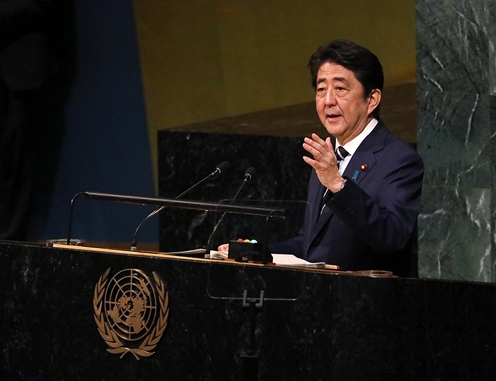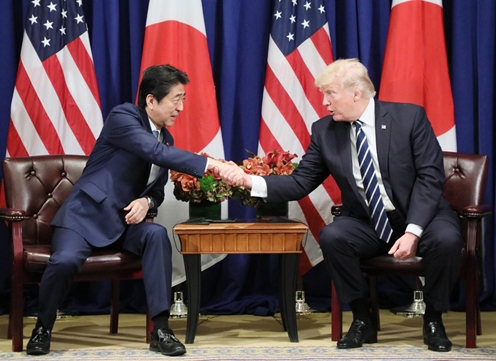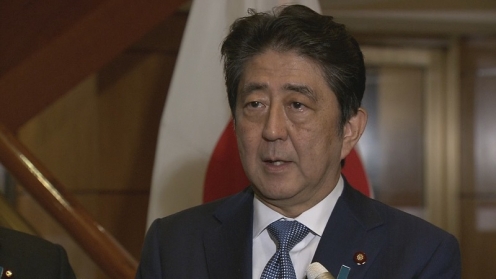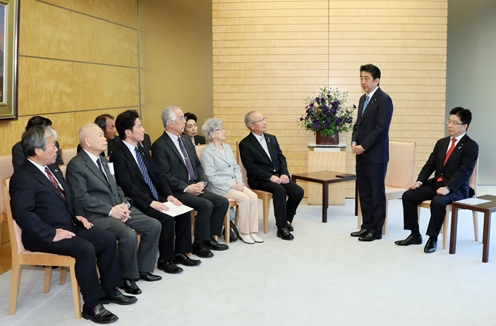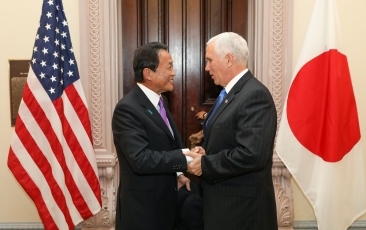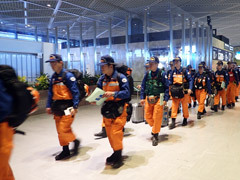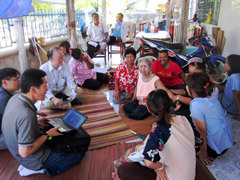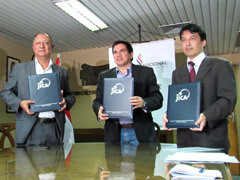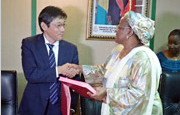Visit to the United States: Third Day
Cabinet Secretariat, Wednesday, September 20, 2017
[Provisional Translation]
On September 20, 2017 (local time), Prime Minister Shinzo Abe, who is visiting New York in the United States of America, delivered a speech on the economy at the New York Stock Exchange, and then attended the HeForShe IMPACT 10x10x10 Parity Report Launch Event. Following this, the Prime Minister held talks with H.E. Mr. Emmanuel Macron, President of the French Republic.
In the afternoon, the Prime Minister gave an address at the General Debate of the United Nations General Assembly, and at night held talks with H.E. Mr. Recep Tayyip Erdogan, President of the Republic of Turkey.
Visit to the United States: Fourth Day
Cabinet Secretariat, Thursday, September 21, 2017
[Provisional Translation]
On September 21, 2017 (local time), Prime Minister Shinzo Abe, who is visiting New York in the United States of America, held talks with H.E. Dr. Miroslav Lajcak, President of the 72nd Session of the United Nations General Assembly.
Later, the Prime Minister held talks with the Honorable Donald Trump, President of the United States of America, and H.E. Mr. Moon Jae-in, President of the Republic of Korea. In the afternoon, Prime Minister Abe held talks with President Trump.
Press Occasion on the Japan-U.S. Summit Meeting and Japan-U.S.-ROK Trilateral Summit Meeting
Cabinet Secretariat, Thursday, September 21, 2017
[Provisional Translation]
On September 21, 2017 (local time), Prime Minister Shinzo Abe held a press occasion in New York in the United States of America.
In regard to the Japan-U.S. Summit Meeting and the Japan-U.S.-ROK Trilateral Summit Meeting, the Prime Minister said,
“I just held summit talks with President Trump of the United States for about an hour and a half. We had an in-depth exchange of views regarding the North Korea threat.
The U.S. gave solid confirmation of its unshakeable commitment to the defense of Japan, and Japan and the U.S. also confirmed that we stand together 100 percent.
Moreover, President Trump mentioned Ms. Megumi Yokota in the address he delivered to the United Nations, sending out a message to the world about the importance of the abduction issue. We confirmed that Japan and the U.S. will work with each other in steady collaboration and cooperation for the release of Japanese abductees and of U.S. nationals incarcerated in North Korea.
We also must ensure that the strict sanctions resolution recently passed is fully implemented and must also apply the greatest possible pressure on North Korea to cause it to change its policies in order to bring a resolution to the nuclear and missile issues as well as the abduction issue.
On this occasion, we also held summit talks among Japan, the U.S., and the Republic of Korea. There can be no doubt that Japan-U.S.-ROK cooperation is becoming stronger as the North Korea threat intensifies. Our three countries were in complete agreement that we will act in unity to appeal vigorously to the international community regarding North Korea. From now, our three countries will cooperate reliably and also work in cooperation with the international community to impose upon North Korea pressure that is by far the most intense to date and cause North Korea to change its policies.
We also agreed to accelerate arrangements for President Trump’s expected visit to Japan within 2017. Although I have held telephone talks with President Trump at timely occasions any number of times until now, I look forward to Mr. Trump coming to Japan in order for us to make Japan-U.S. relations even more robust while deepening our countries’ bonds of friendship.”
Meeting with Families of Abductees and Others
Cabinet Secretariat, Thursday, September 28, 2017
[Provisional Translation]
On September 28, 2017, Prime Minister Shinzo Abe held a meeting with families of abductees and others at the Prime Minister's Office.
The Prime Minister said in his address,
“The last time we met I promised that I would discuss the importance of the abduction issue at the General Assembly of the United Nations in my address at the General Debate, and that I would emphasize to the leaders of each country, including President Trump, just how important the abduction issue is, not only for Japan, but the entire world. Today, I would like to report on these promises. First, I would like to express my gratitude to all of you for taking the time out of your busy schedules to visit the Prime Minister’s Office.
During my address at the General Debate, I emphasized the importance of the abduction issue for Japan and the egregious violation of human rights it represents. I will urge the international community to work together to resolve this issue. During the Japan-U.S. Summit Meeting with President Trump and the Japan-U.S.-Republic of Korea Summit Meeting, I emphasized to those in attendance the importance of resolving the current nuclear issue and abduction issue in unison. Also, I thanked President Trump for becoming the first U.S. President to talk about Ms. Megumi Yokota and the abduction issue during an address to the General Debate. Furthermore, I explained that I would like to work together in the future to resolve the abduction issue and the United States has agreed to cooperate. I will continue to emphasize the importance of this abduction issue to the international community.
At the United Nations General Assembly, I took the opportunity to hold summit meetings with President Emmanuel Macron of France and other leaders, where I talked about the importance of the abduction issue.
Afterwards, I would like to provide all of you with a more detailed report on my activities.”
The Second Round of the Japan-U.S. Economic Dialogue
Foreign Affairs, Tuesday, October 17, 2017
On October 16 (local time), commencing at 2:40 p.m. for approximately one hour and 50 minutes, Mr. Taro Aso, Deputy Prime Minister, while visiting Washington D.C., held the second round of the Japan-U.S. Economic Dialogue with the Honorable Mike Pence, Vice President of the United States of America, at the White House. Following the Dialogue, Deputy Prime Minister Aso and Vice President Pence issued a Japan-U.S. Joint Press Release (PDF). The Dialogue was attended on the U.S. side by the Honorable Wilbur Ross, Secretary of Commerce, the Honorable Steven Mnuchin, Secretary of the Treasury, the Honorable Robert Lighthizer, United States Trade Representative, H.E. Mr. William F. Hagerty, U.S. Ambassador to Japan, Mr. Everett Eissenstat, Deputy Assistant to the President for International Economic Affairs, Ms. Aiko Lane, Special Advisor to the Vice President, Ms. Joan O’Hara, Deputy National Security Adviser to the Vice President, and others; and on the Japanese side by Mr. Kenichiro Sasae, Japanese Ambassador to the United States, Mr. Kazuyuki Yamazaki, Senior Deputy Minister for Foreign Affairs, Mr. Masatsugu Asakawa, Vice-Minister of Finance for International Affairs, Mr. Hiromichi Matsushima, Vice-Minister for International Affairs, Ministry of Agriculture, Forestry and Fisheries, Mr. Tadao Yanase, Vice-Minister for International Affairs, Ministry of Economy, Trade and Industry, Mr. Hiroshi Tabata, Vice-Minister for International Affairs, Ministry of Land, Infrastructure, Transport and Tourism, Mr. Kanji Yamanouchi, Director-General, Economic Affairs Bureau, Ministry of Foreign Affairs, Mr. Shigehiro Tanaka, Director-General, Trade Policy Bureau, Ministry of Economy, Trade and Industry, and others.
The overview of the Dialogue is as follows.
1 Opening Remarks
Deputy Prime Minister Aso and Vice President Pence appreciated that working-level officials from both Japan and the United States have been holding energetic discussions since the first round of the Economic Dialogue, in order to obtain concrete results along the three pillars that were confirmed at the first round of this dialogue. It was also confirmed that North Korea poses an unprecedented, grave and imminent threat, and amid the increasingly severe security environment in the Asia-Pacific region, it is important to pursue constructive dialogue from here forward in order to further deepen the Japan-U.S. economic relationship, which is of great strategic importance.
2 Common Strategy on Trade and Investment Rules / Issues
With regard to bilateral trade issues, both sides confirmed (1) that restrictions on Japanese persimmons and on U.S. potatoes from Idaho were lifted, and (2) that Japan will streamline noise and emissions testing procedures for U.S. automobile exports certified under Japan’s Preferential Handling Procedure (PHP) in the area of automobile trade. Furthermore, both sides also confirmed that Japan will (3) ensure transparency and fairness in its system for geographical indications (GIs) in accordance with its domestic law and procedures, and will (4) ensure transparency continuously with respect to reimbursement policies related to life sciences innovation.
Additionally, both sides confirmed that technical-level work is underway to strengthen effective enforcement activities against unfair trade practices and to promote high trade and investment standards.
3 Cooperation in Economic and Structural Policies
Both sides (1) reaffirmed the active use of the three-pronged approach affirmed by the G7 members. Additionally, the two sides (2) shared recognition on the current state of the global economy and finance, including financial regulatory regimes, and that they will cooperate on the challenges, and (3) confirmed that both sides, as major shareholders in the multilateral development banks, will work closely together to promote sustainable and inclusive development, consistent with the highest international standards and debt sustainability.
4 Sectoral Cooperation
Deputy Prime Minister Aso and Vice President Pence welcomed that effective and broad-ranging discussions are taking place in working groups set up by both sides in sectors where it will be possible to promote economic benefits and job creation in both countries, and that both sides are attaining concrete achievements that are enabling the win-win relationship between Japan and the United States to be further strengthened.
In this context, both sides confirmed they will deepen discussions in areas such as (1) cooperation in the transportation infrastructure sector, including measures to deal with infrastructure deterioration and the development of high-speed rail, increased investment and promotion of quality infrastructure through infrastructure development in third countries; (2) energy ties, including liquefied natural gas, civil nuclear energy and energy infrastructure; (3) leveling the global playing field; (4) cooperation in the digital economy; and (5) inclusive workforce participation, including women’s economic participation.
5 Concluding remarks
Deputy Prime Minister Aso and Vice President Pence welcomed that meaningful and constructive discussions had taken place. Moreover, sharing the importance of continuing the Japan-U.S. Economic Dialogue, they shared the view that the schedule for the next Dialogue will be coordinated at the working level on both sides.
METI Minister Seko Visits the Philippines, Thailand and Viet Nam
METI, Tuesday, September 19, 2017
METI Minister Seko Visits the Philippines, Thailand and Viet Nam
From September 8 to 15, 2017, Mr. Hiroshige Seko, Minister of Economy, Trade and Industry, visited Manila, the Philippines, Bangkok, Thailand, and Hanoi, Viet Nam.
In the Philippines, he attended the ASEAN Economic Minister (AEM) - METI Consultation, a Regional Comprehensive Economic Partnership (RCEP) Ministerial Meeting and other meetings, and also held bilateral meetings with: H.E. Ramon M. Lopez, Secretary of Trade and Industry of the Philippines, chair of ASEAN in 2017; H.E. Mr. Lim Hng Kiang, Minister for Trade and Industry of Singapore, expected chair of ASEAN in 2018; H.E. Mr. Suresh Prabhu, Minister of Commerce and Industry of India; and H.E. Mr. Steven Ciobo, Minister for Trade, Tourism and Investment of Australia.
In Thailand, with a mission of approximately 600 members from Japanese companies organized by JETRO, Minister Seko held meetings with: H.E. Mr. Prayuth Chan-o-cha, Prime Minister, H.E. Dr. Somkid Jatusripitak, Deputy Prime Minister, and H.E. Mr. Uttama Savanayana, Minister of Industry. Following this, he attended a symposium focusing on the subject of industrial sophistication in Thailand and other events.
In Viet Nam, Minister Seko held bilateral meetings with: H.E. Mr. Nguyen Duc Chung, Chairman, Ha Noi People’s Committee; H.E. Mr. Hoang Trung Hai, Secretary of the Ha Noi Party Committee; H.E. Mr. Tran Tuan Anh, Minister of Industry and Trade; H.E. Mr. Nguyen Xuan Phuc, Prime Minister; and H.E. Mr. Pham Minh Chinh, President of the Viet Nam-Japan Parliamentary Friendship Association. At each meeting, both sides exchanged frank views concerning the further development of the Japan-Viet Nam relationship.
1. Deepening and expanding Japan-ASEAN economic and industrial cooperation
AEM - METI Consultation
At the AEM - METI Consultation in September 9, member countries showed their gratitude to Japan for organizing the ASEAN Economic Ministers Roadshow (AEM Roadshow) held in April 2017 in Japan. To ASEAN economies celebrating the 50th anniversary of the foundation, Japan proposed an effort toward future Japan-ASEAN cooperation in order to deepen regional economic integration and solve challenges that have become more and more complex and diversified in member economies. Following this, participants exchanged views concerning the details of this issue.
Specifically, Minister Seko proposed an effort titled “ASEAN-Japan Cooperation towards Innovation-led Inclusive Growth,” consisting of the following three pillars:
1)Promotion of ASEAN-Japan collaboration for further innovation,
2)Enhancement of Japan’s support for inclusive growth for MSMEs in ASEAN economies, and
3)Providing support for introduction of RCEP rules that will promote trade.
In particular, concerning the promotion of Japan-ASEAN collaboration towards innovation, Japan proposed the ASEAN-Japan Innovation Platform Concept, in which public-private collaboration efforts will facilitate projects, including projects aimed at developing the Connected Industries policy in ASEAN. Ministers expressed interest in the concept and welcomed its further development.
In addition, the Federation of Japanese Chambers of Commerce and Industry in ASEAN (FJCCIA) presented a series of requests and proposals amalgamated from approximately 7,000 Japanese affiliates in the ASEAN region, to the ASEAN economies. In response, the economies stated that they will endeavor to realize the requests.
Moreover, concerning the ASEAN-JAPAN Innovation Network which is a framework proposed by Minister Seko at the AEM - METI Consultation in 2016 and established with the opportunity provided by the AEM Roadshow in April 2017 with the aim of advancing business collaboration for Japan-ASEAN innovation, the Japan Section of the ASEAN-JAPAN Business Council (AJBC) reported the efforts under the framework, while the ASEAN economies welcomed Japan-ASEAN collaborative business activities.
Furthermore, concerning a Japan-ASEAN Fair, an event proposed by Secretary Lopez at the AEM Roadshow in April 2017, Minister Seko declared that the event would be held during the opportunity provided by an ASEAN-related Summit Meeting to be held in November 2017. Participating countries expressed significant interest regarding this statement.
At the fifth RCEP Ministerial Meeting held in September 10, the Ministers discussed on the way forward concerning the negotiations, after the current state of overall negotiations, in the area of market access in goods, services and investment, as well as rules was reported.
In particular, the Ministers endorsed the Key Elements which cover not only market access but also rules, which were originally proposed by Minister Seko agreed at the intersessional Ministerial Meeting in Hanoi in May 2017, and chief negotiators agreed at the Trade Negotiating Committee in July 2017, Minister Seko stated that Japan will proactively cooperate with the ASEAN economies on human resource developments and institution arrangements for rule-making, e.g., for e-commerce.
The Ministers agreed to make utmost efforts to achieve significant outcomes of the RCEP by the end of 2017 at the Summit Meeting in November 2017.
2. Meetings with participating countries
Minister Seko directly delivered Japan’s Proposal for Formulating Industrial Vision in the Philippines to Secretary Lopez at their bilateral meeting. In response, Secretary Lopez expressed his gratitude for Japan’s contribution to the county, considering the proposal as a reference for industrial policies for the Philippines. At the bilateral meetings with Minister Lim, Minister Prabhu, and Minister Ciobo, Japan received proactive views from each of them concerning a well-balanced conclusion of the RCEP. At the bilateral meeting with Minister Prabhu, Minister Seko was provided with a proposal for formulating common strategies with Japan for dealing with challenges commonly to both Japan and India.
3. Visiting Thailand
Minister Seko visited Thailand with a mission of approximately 600 members from Japanese companies, consisting of: a nation-wide mission organized by JETRO and co-organized by KEIDANREN, the Japan Chamber of Commerce and Industry and SME Support JAPAN; and regional missions of regional Japanese companies from Tokyo, the Kansai region, and Fukuoka, Hokkaido, Toyama, Ehime, Akita, Shimane and Mie Prefectures.
Minister Seko paid courtesy calls to Prime Minister Prayuth on September 11 and Deputy Prime Minister Somkid on September 12. Thailand expressed strong hopes to Japan that Japanese companies, which are contributors to current economic growth in the country, will also play significant roles in achieving industrial sophistication efforts being advanced by Thailand under its policies, e.g., Thailand 4.0 and Eastern Economic Corridor (EEC). Moreover, at the meeting with Deputy Prime Minister Somkid, both sides recognized the importance of cooperating in increasing the sophistication of Thailand’s industries by taking advantage of Japan’s Connected Industries concept addressing the fourth industrial revolution. They also shared the recognition of the importance of enhancing connectivity between Thailand and the Mekong region, ASEAN economies and other adjacent regions. In addition, both sides engaged in discussion concerning proposals from Japanese companies on the EEC policy.
On September 12, Minister Seko attended a symposium, bringing together Deputy Prime Minister Somkid, Minister Uttama, and other Thai government officials and industrial players as well as people from related Japanese organizations and industrial players, and held discussions on specific case examples of efforts for industrial sophistication conducted in Thailand under the Connected Industries concept.
On September 13, Minister Seko, with a mission of Japanese companies, visited U-Tapao International Airport located in the EEC. At the airport, Minister Seko held a meeting with Minister Uttama. Both sides engaged in discussions on the importance of opinions offered by Japanese companies and other issues.
4. Visiting Viet Nam
In Viet Nam, Minister Seko held bilateral meetings with: Chairman Chung, Secretary Hai, Minister Anh, Prime Minister Phuc, and President Chinh. At the meetings with Chairman Chung and Secretary General Hai, both sides meaningfully exchanged views mainly concerning infrastructure projects and investment environments for Japanese companies in Hanoi.
At the meeting with Minister Anh, both sides concluded a Package of Joint Strategic Cooperation between Japan and Viet Nam, aiming to further promote cooperation based on the agreement concluded at the Second Meeting of the Japan-Viet Nam Joint Committee on Cooperation in Industry, Trade and Energy held in Tokyo in June 2017.
The package consists of three pillars:
[ⅰ] enhancement of industrial competitiveness,
[ⅱ] capacity building, and
[ⅲ] energy and Infrastructure cooperation to support growth.
At the meeting with Minister Phuc, both sides exchanged views concerning regional economic circumstances, including those surrounding RCEP, TPP and APEC. While Japan explained the details of the package concluded with Minister Anh, both sides exchanged views concerning Japan-Viet Nam industrial cooperation. Moreover, at the meeting with President Chinh, both sides exchanged views concerning Japan-Viet Nam economic ties and regional circumstances.
Emergency Assistance to Viet Nam in Response to the Torrential Rainfall Disaster
Foreign Affairs, Thursday, October 19, 2017
1. Today, October 19, upon the request of the Government of the Socialist Republic of Viet Nam, the Government of Japan decided to provide emergency relief goods (plastic sheets, blankets and water purifiers) through the Japan International Cooperation Agency (JICA) to Viet Nam in response to the damages caused by the recent torrential rainfall.
2. Upon the request of the Government of the Socialist Republic of Viet Nam, and in light of the humanitarian perspective and the close relations between Japan and Viet Nam, Japan decided to provide emergency assistance to Viet Nam to meet its humanitarian needs.
(Reference)
In Viet Nam, from around October 10 (local time), floods and landslides caused by continuous torrential rainfall mainly in northern and north-central region of the country, resulted in a large number of those affected including the loss of lives, and much physical damage. According to the Government of Viet Nam, as of October 16, 75 people died, 28 people have been missing, 38 people have been injured and 2,604 households have been evacuated.
‘Japan Disaster Relief Team: 30 Years On’ Part 1: Highly Rated Search and Rescue Team Assists After Mexico Quake
JICA, Wednesday, October 4, 2017
Around 3:15 a.m. Japan time on Sept. 20, a magnitude 7.1 earthquake took place in central Mexico. At the request of the government of Mexico, the government of Japan that day decided to dispatch the Japan Disaster Relief (JDR) Search and Rescue Team. On the afternoon of Sept. 21, the SAR team, wearing orange and blue uniforms, flew from Japan bound for Mexico, where it conducted search and rescue operations in central Mexico City from Sept. 22 to 25.
Five teams, including Search and Rescue and Medical, with JICA serving as the secretariat
It has been 30 years since the enactment of the Law Concerning Dispatch of JDR Team, which is the legal basis for the activities of the JDR team. The team has worked at the sites of major disasters including the recent Mexican earthquake; the 2004 Indian Ocean earthquake and tsunami; the 2008 Sichuan earthquake; and Typhoon Haiyan, which struck the Philippines in 2013. The JDR team consists of a SAR Team, a Medical Team, an Infectious Disease Response Team, an Expert Team and Japanese Self-Defense Force units. Single or multiple teams are dispatched depending on the type and scale of the disaster and the requests of the government of the affected country. The JDR team, operated by the Secretariat of JDR Team JICA, continues to evolve 30 years after its founding.
Heading for disaster sites with generators, power cutters and rescue dogs
The SAR team dispatched for the Mexico earthquake consisted of 72 people. They took a lot of equipment with them, including power generators, lighting equipment and power cutters. Four rescue dogs and their handlers accompanied the team.
The first task confronting the SAR Team when it arrives at a site is securing its own safety. In the April 2015 Nepal earthquake, the team worked at the site of collapsed brick buildings. The team transported bricks by hand, and to search for people left in the collapsed building, it made a hole in the leaning third-floor section and used it to send a camera into the lower floors.
"The vibration from the equipment for cutting a hole in the floor made the whole building seem to shake," said team member Toshiyasu Sumikawa, an officer of the Tokyo Metropolitan Police Department.
To secure the team's safety near the collapsed buildings, experts on evaluating the structures of buildings joined the team and worked alongside it.
Practical training on everything from search & rescue to medical care and logistics
photo
The team was formed in response to two disasters that occurred in 1985: an earthquake in Mexico and a volcanic eruption in Colombia. Though medical teams were dispatched, it became clear that a comprehensive structure that includes experts on search & rescue and disaster response is needed for emergency relief. The SAR Team was dispatched for the first time in response to a 1990 earthquake in Iran, and this most recent dispatch was its 20th.
The SAR Team is responsible for finding and rescuing victims and giving first aid during major disasters. The SAR Team is made up of police, firefighters, members of the Japan Coast Guard, and coordinators at JICA responsible for logistics. In 2010, the International Search and Rescue Advisory Group classified the SAR Team as "heavy,” the highest level. This classification is only given to high-capacity teams that can work at two separate locations at the same time and work in the collapsed parts of buildings and other structure.
The team undergoes comprehensive training twice a year to improve its rescue skills. Using a scenario similar to an actual disaster, members learn how to rescue people from a building threatening to collapse and how to maintain equipment. The Medical Team learns how to provide medical care to people trapped in a building.
The team was recertified as heavy in 2015 after maintaining its high capacity level and continually working to improve through this kind of training.
The government and people of Mexico showed deep gratitude to the SAR Team — which has continued to accumulate experience and evolve — for its work at the site of the Mexico earthquake.
Japanese-style long-term care system introduced in graying Thailand, also influencing neighboring countries
JICA, Thursday, October 12, 2017
Japan is known for the rapid pace at which its population aged. Actually, however, population aging continues in all the countries of Southeast Asia, as well, with no exceptions. In Thailand, population aging is outpacing what happened in Japan, and the government there is hurrying to build a long-term care system for the elderly.
JICA has been providing support for elderly Thai people for more than 10 years, and a project that ended in August developed long-term care services that suit the situation in Thailand. The project was found to have been highly effective: Many elderly people who received long-term care services responded that they improved their physical function, and the Thai government incorporated the results of the project into its long-term care policies.
Providing individualized care that combines health and welfare services
In 2000, Japan introduced a long-term care system that provides long-term care services using the support of the entire society. At the center of this system are care managers (long-term care support specialists) who check on the situation of each elderly person and create a care plan that combines various health and welfare services to match his needs. This process is known as "care management."
In 2013, Thailand began the Project on Long-Term Care Service Development for the Frail Elderly and Other Vulnerable People (LTOP) in an effort to use a similar system to Japan's. The project set three goals it is working to achieve in six regions:
1. Developing a model for the provision of elderly long-term care services
2. Developing a program to train long-term care workers
3. Making policy recommendations
In Thailand, care of elderly people has been carried out by individual hospitals, health care centers and local governments, with almost no coordination among them, resulting in inadequate provision of efficient services to the elderly.
So, the project is training nurses at hospitals who have handled local nursing care to be case managers with the goal of introducing care management like that in Japan. Health care workers at local governments have also gotten involved, and the country has managed to introduce such a system. In addition, care centers and care visits to the homes of the elderly have begun, making it possible to provide more extensive and warm care than in the past.
There is data showing that through these initiatives, 65 percent of the people served by the program in the target regions have seen improvements in indicators of daily movements including eating, changing clothes, moving, going to the bathroom, straightening their posture and bathing.
Using Japanese experience and expertise, the project also has made proposals to the government regarding creating a structure to make the long-term care service model sustainable and securing financial resources.
The long-term care services model expands from Thailand to other countries
In June, a seminar was held in Bangkok to share the results of the project with neighboring countries. 22 people from 10 countries including Malaysia and Vietnam participated and learned about Thailand's long-term care services model and its effects.
Based on the results so far, a new project emphasizing strengthening coordination between medical care and long-term care will begin in October. In Thailand, a fair number of elderly people who have a stroke or a fracture are quickly discharged from the hospital without making a functional recovery, and as a result they become bed-ridden. The project will look for ways, including rehabilitation, of avoiding people becoming dependent on a caregiver. Because Japan experienced population aging slightly earlier than Southeast Asia, JICA has experience and expertise in this area, and it will continue supporting the creation of long-term care service models that match the current situation of each country.
Signing of Record of Discussions on Technical Cooperation Project with Paraguay: Contributing to the production of safe crops for export by improving the quality control system for crops produced by small-scale farmers
JICA, Thursday, October 5, 2017
On September 20, the Japan International Cooperation Agency (JICA) signed a Record of Discussions with the Government of the Republic of Paraguay in Asunción, the capital city, for the Project for Improving Safety of Agricultural Exports for Small-Scale Farmers, a technical cooperation project.
The project will promote the appropriate quality management of crops by small-scale farmers in the Asunción Capital District and a target department, and improve the pre-export inspection system for crops, contributing to a larger quantity of export crops that meet safety standards.
In Paraguay, the profitable cultivation of sesame began to spread widely as a cash crop of small-scale farmers in the 1990s, becoming an important source of revenue. Paraguayan sesame is highly desired on the Japanese market for its fine quality, and the export volume to Japan rose rapidly in the 2000s, and Paraguay became the largest exporter of sesame to Japan in 2008. However, there was a series of incidents in 2013 in which residual agricultural chemicals were found to exceed Japanese standards known as the Maximum Residue Limits during the import inspection, resulting in the Ministry of Health, Labour and Welfare issuing an order subjecting Paraguayan sesame to inspection. At the same time, there was a drop in the productivity and quality of escoba sesame, a high-quality variety of Paraguayan sesame, caused by soil disease and other issues, and additional competition also emerged in the international sesame market particularly from African countries, reducing the competitiveness of Paraguayan sesame.
By improving the quality control system of the entire value chain from production to distribution and export, the project is expected to increase the quantity of crops being produced for export, including sesame, that meet safety standards, and to contribute to improvements in the livelihoods of small-scale farmers. In addition to this project, JICA has dispatched an advisor for 2016 and 2017 to Paraguay to assist in reducing the residual agricultural chemicals in the crops of small-scale farmers, and is enhancing the traceability of agricultural chemicals and the sampling system, contributing to improved safety in export crops from Paraguay and strengthened market competitiveness.
Signing of Grant Agreement with Guinea: Contributing to an improved learning environment for children through the construction of primary and secondary schools
JICA, Thursday, October 5, 2017
On October 4, the Japan International Cooperation Agency (JICA) signed a grant agreement with the Government of the Republic of Guinea in Conakry, the capital city, to provide grant aid of up to 1.913 billion yen for the Project for Construction of Primary and Secondary Schools in Urban Areas Phase II.
The project will construct primary and secondary schools, and provide schoolroom furniture and other furnishings in Conakry, where there is a severe lack of schoolrooms, thereby contributing to improvements in access to primary and secondary schools and in the quality of education in the target region.
Although the gross enrollment rates in primary and secondary schools have risen to 84.5 percent (2015) and 38.0 percent (2014) in Guinea in recent years, further improvements are needed. One cause that may be given for the continuing need for improvements is that the number of primary and secondary schools has not kept pace with the increasing number of enrolling students that has accompanied the population influx in Conakry. The overcrowding of classrooms is particularly severe there due to a rapid increase in the number of enrolling students, with some classrooms having more than double the standard number of students (48) learning in one classroom. Many schools operate lessons in two shifts to compensate for the lack of classrooms, resulting in an inadequate amount of time for lessons.
The project will build approximately 123 more classrooms in nine primary schools and 63 more classrooms in three secondary schools in Conakry, which is expected to allow approximately 8,900 more students to enroll. This will alleviate the overcrowding of classrooms and eliminate the need for lessons in two shifts, which should improve the learning environment. In addition, separate lavatories for boys and girls will be provided, which will make it easier for female students to attend school, and adequate classroom furniture will be provided to improve the educational environment, which is expected to contribute to an improved quality of education


























